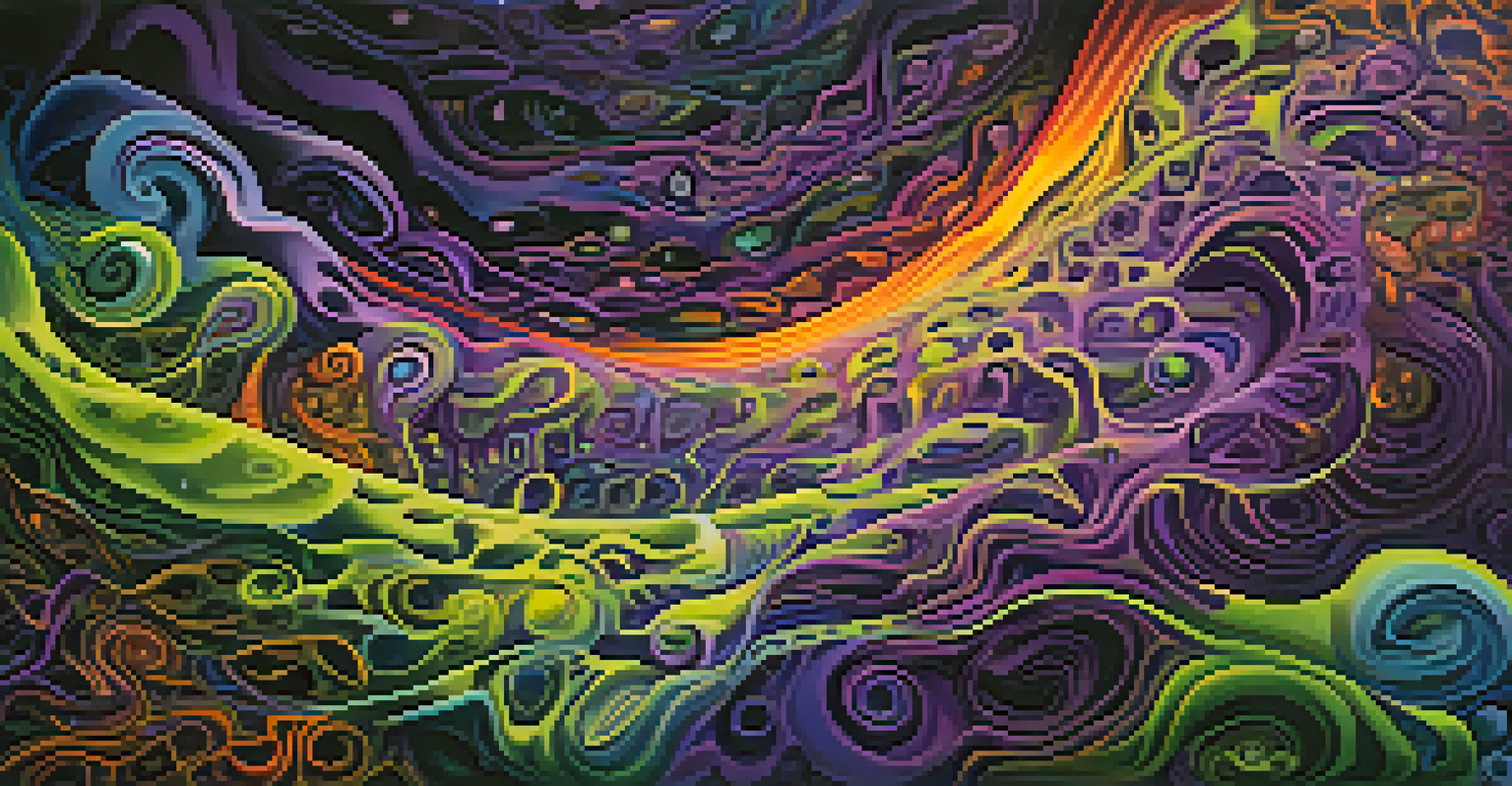Ayahuasca and Its Therapeutic Potential in Modern Psychology

Understanding Ayahuasca: A Brief Overview
Ayahuasca is a powerful plant-based brew originating from the Amazon rainforest, primarily made from the Banisteriopsis caapi vine and the leaves of the Psychotria viridis plant. Traditionally used by indigenous tribes in shamanic rituals, it’s gaining attention in the modern world for its potential therapeutic benefits. The brew contains psychoactive compounds like DMT (dimethyltryptamine), which can induce profound alterations in consciousness and perception.
The use of Ayahuasca is a profound journey into the self, a path to healing that requires not just courage but also respect for its origins.
This brew has been revered for centuries, not just for its psychedelic effects but also for its ability to facilitate deep introspection and emotional healing. Many users report life-changing experiences that lead to greater self-awareness and emotional release. As mental health issues continue to rise globally, the interest in alternative therapeutic methods, including Ayahuasca, is becoming increasingly relevant.
In recent years, research into Ayahuasca has ramped up, with studies highlighting its potential to treat conditions such as depression, anxiety, and PTSD. As the conversation around mental health becomes more expansive, Ayahuasca stands out as a fascinating intersection of traditional wisdom and modern psychology.
The Science Behind Ayahuasca's Effects
At the heart of Ayahuasca's therapeutic potential lies its unique chemical composition. DMT, the primary psychoactive compound, interacts with serotonin receptors in the brain, which can lead to altered states of consciousness. This interaction can help individuals process trauma and emotions that may be difficult to access in a regular state of mind.

Moreover, research suggests that the brew can stimulate neuroplasticity—the brain’s ability to reorganize itself by forming new neural connections. This is particularly valuable for those dealing with mental health issues, as it may enhance their ability to change negative thought patterns and behaviors. In essence, Ayahuasca might not just provide temporary relief but could also catalyze lasting change in one’s mental landscape.
Ayahuasca's Healing Potential
Ayahuasca, a traditional Amazonian brew, shows promise in addressing mental health issues like depression and PTSD through its unique psychoactive properties.
It's important to note that while the science is promising, the experiences with Ayahuasca can vary greatly from person to person. Factors such as set (mindset) and setting (environment) play a crucial role in shaping an individual’s journey and the insights they gain.
Cultural Significance of Ayahuasca
Ayahuasca is deeply rooted in the cultural traditions of the Amazonian tribes, where it is often used in ceremonial settings led by skilled shamans. These ceremonies are not simply about consuming the brew; they involve rituals, music, and guidance that create a supportive environment for healing. The shaman’s role is to help participants navigate their experiences, which can sometimes be intense and challenging.
Ayahuasca offers a unique opportunity to explore the depths of the mind and spirit, revealing insights that can transform one's understanding of themselves.
The cultural significance of Ayahuasca also emphasizes community and connection. Participants often report feeling a profound sense of unity with others and the natural world during their experience. This collective aspect of healing can be incredibly powerful, as it reinforces the idea that we are not alone in our struggles.
As Ayahuasca moves into a more global context, there’s a growing conversation about cultural appropriation and the importance of respecting its origins. Engaging with Ayahuasca should involve an awareness of its traditional uses and the cultural heritage that surrounds it.
Ayahuasca and Modern Therapy: A Complementary Approach
Many mental health professionals are beginning to explore how Ayahuasca can complement traditional therapeutic methods. When combined with psychotherapy, the insights gained during an Ayahuasca journey can enhance the therapeutic process, allowing for deeper exploration of emotions and experiences. This collaborative approach can be particularly beneficial for individuals who have felt stuck in their healing process.
For instance, after an Ayahuasca experience, a person might find it easier to articulate feelings or memories they previously struggled with. This newfound clarity can lead to more productive therapy sessions, where both the therapist and the client can delve into these insights together. In this way, Ayahuasca is seen not as a replacement for therapy, but rather a powerful tool to enhance therapeutic outcomes.
Cultural Respect is Crucial
Engaging with Ayahuasca requires an understanding of its cultural significance and the importance of respecting its indigenous roots.
However, it’s crucial that anyone considering this approach does so under the guidance of experienced professionals who understand both the psychological and physiological aspects of Ayahuasca. Safety, integration, and support are key components of this journey.
Potential Risks and Considerations
Despite its promising benefits, Ayahuasca is not without potential risks. The intense nature of the experience can lead to challenging emotional confrontations, and for some, it may exacerbate existing mental health issues. Those with a history of schizophrenia or bipolar disorder, for example, may be advised against using Ayahuasca, as it could trigger or worsen symptoms.
Additionally, the physical effects of Ayahuasca can include nausea, vomiting, and diarrhea, which are often viewed as part of the purging process. While many participants find this purging to be a necessary and cathartic aspect of the experience, it can be off-putting for others. It’s essential for individuals to weigh these aspects before embarking on their Ayahuasca journey.
Lastly, the legality of Ayahuasca varies by region, and it’s important for individuals to understand the legal implications of participating in Ayahuasca ceremonies. Researching reputable retreats and understanding the cultural context are crucial steps in ensuring a safe and respectful experience.
Integration After the Ayahuasca Experience
Integration is a vital aspect of the Ayahuasca journey, as it involves processing and making sense of the insights gained during the experience. Many participants find that the real work begins after the ceremony, as they navigate the emotions and revelations that surface. This is where support systems, such as therapists or integration circles, can play a crucial role.
During integration, individuals often reflect on their experiences, helping to solidify the lessons learned. Journaling, discussing experiences with peers, or engaging in mindfulness practices can all aid in this process. The goal is to bring the insights into daily life, fostering personal growth and healing.
Integration Enhances Benefits
Proper integration following an Ayahuasca experience is essential for translating insights into lasting personal growth and healing.
Moreover, integration can enhance the long-term benefits of Ayahuasca, ensuring that the experience translates into meaningful change. Without proper integration, individuals may find themselves returning to old patterns, diluting the potential impact of their journey.
The Future of Ayahuasca in Mental Health Treatment
As interest in alternative therapies grows, Ayahuasca is carving a niche in the landscape of mental health treatment. Ongoing research and clinical trials are exploring its efficacy and safety, paving the way for a deeper understanding of its role in healing. This growing body of evidence may eventually lead to more widespread acceptance within the medical community.
Furthermore, as the stigma surrounding mental health continues to diminish, individuals are becoming more open to exploring diverse treatment options. Ayahuasca could serve as a bridge between traditional psychological practices and holistic healing approaches, offering new avenues for those seeking relief from their struggles.

However, it’s essential that this exploration is done with respect for its cultural roots and a commitment to ethical practices. The future of Ayahuasca in mental health treatment holds promise, but it requires careful navigation to ensure that it benefits those who seek its healing powers.